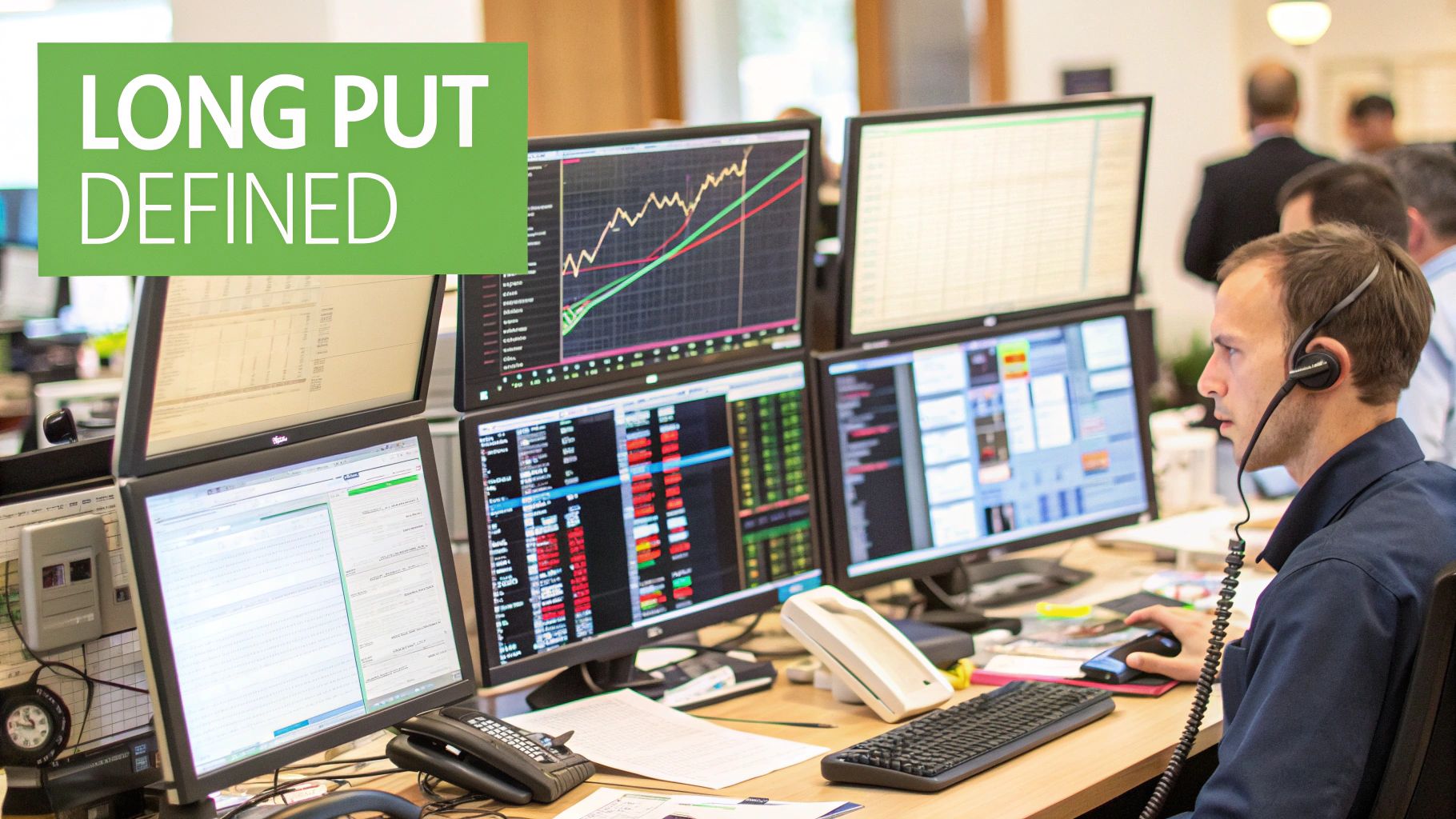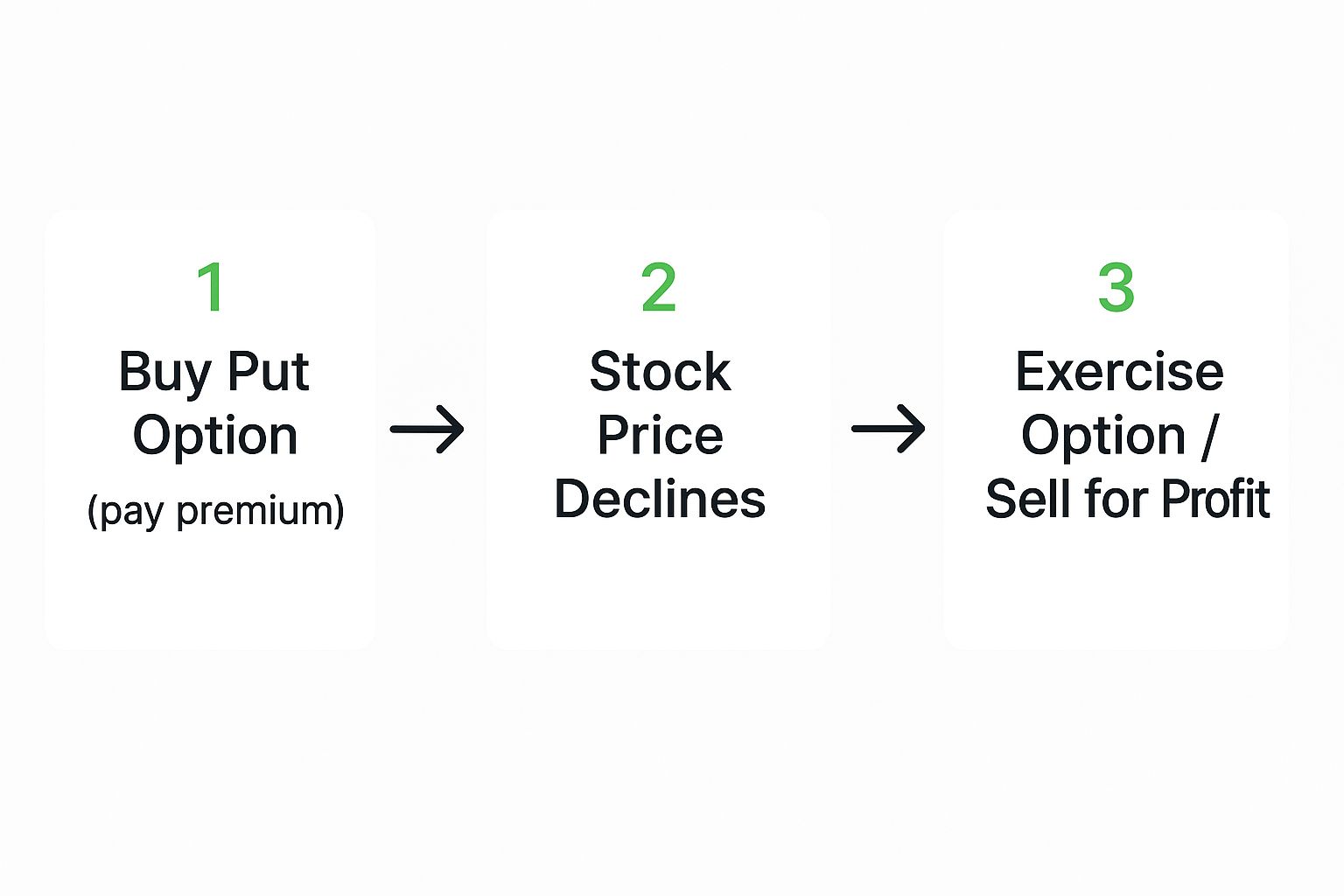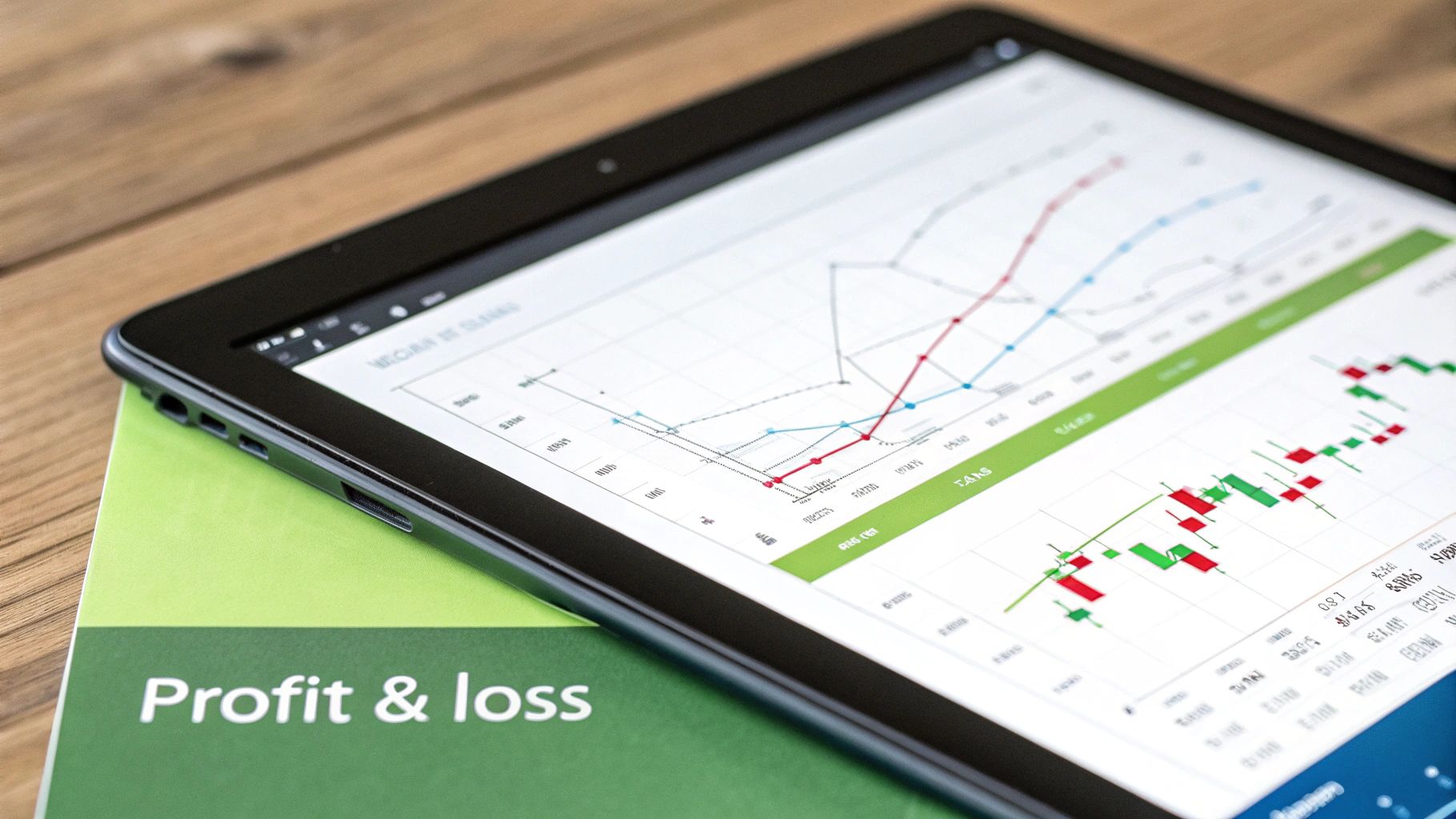What Is a Long Put Option? A Complete Guide to Profitable Strategies
If a stock moves past your strike, the option can be assigned — meaning you'll have to sell (in a call) or buy (in a put). Knowing the assignment probability ahead of time is key to managing risk.
Posted by
Related reading
Mastering Option Extrinsic Value
Unlock the core of options trading by mastering option extrinsic value. Learn how time, volatility, and strategy impact your profits with this guide.
A Trader's Guide to Short Put Options
Discover how to use short put options to generate consistent income or buy stocks at a lower price. This guide covers key strategies and risk management.
8 Best Stocks for Put Selling in 2025
Discover the best stocks for put selling to generate consistent income. Our guide breaks down top picks, key metrics, and actionable strategies for success.
A long put option is a contract that gives you the right—but not the obligation—to sell a stock at a guaranteed price by a certain date.
Think of it as buying insurance for your stock portfolio. Or, more aggressively, making a calculated bet that a stock's price is headed for a downturn. It's one of the most popular bearish strategies out there because the profit potential can be massive, while the risk is strictly limited.
Decoding the Long Put Option

At its heart, buying a long put is how you express a negative or "bearish" view on a stock or even the entire market. Forget the headaches of short-selling a stock; a long put offers a much simpler path with a clearly defined maximum loss.
You're just purchasing a contract. That's it. The absolute most you can ever lose is the initial amount you paid for it, no matter how wrong you are.
This strategy is built on a few core pieces that all work together. Let's quickly review the key components of a long put option contract.
Key Components of a Long Put Option at a Glance
The table below breaks down the fundamental elements of a long put option. Understanding these terms is the first step to confidently trading puts.
| Component | Description | Example |
|---|---|---|
| Underlying Asset | The specific stock or ETF that your option contract covers. | 100 shares of Apple Inc. (AAPL) |
| Strike Price | The predetermined price where you have the right to sell the asset. You want the stock to drop below this. | $170 |
| Expiration Date | The final date your contract is valid. Your right to sell the stock at the strike price ends here. | The third Friday of next month |
| Premium | The cost you pay upfront to buy the option contract. This is your maximum possible loss. | $3.50 per share ($350 total for one contract) |
These four components define every trade. Getting comfortable with how they interact is crucial for making smart decisions.
The Mechanics of Cost and Profit
So, how does a long put actually make you money? It's a bearish strategy where you buy a contract giving you the right to sell a stock at a set price (the strike) before it expires. Most standard options contracts in the U.S. cover 100 shares.
Let's walk through an example. Say you buy one put option on a stock with a $95 strike price. You pay a premium of $5 per share. Your total cost for this one contract is $500 ($5 x 100 shares).
Your breakeven point is the strike price minus the premium you paid. In this case, that's $90 ($95 - $5). If the stock falls significantly below $90, your profit potential can be substantial. But if the stock stays above $95? Your maximum loss is capped at the $500 premium you paid. That's all you can lose.
If you'd like a deeper dive into how these contracts are put together, check out our complete guide on how options work.
Why Is It Called ‘Long’?
The term "long" can throw people off, since we usually associate it with bullish positions, like being "long stock." In the world of options, "long" simply means you bought and now own the contract.
You are "long a put," which just means you are the owner of a put option. This is the opposite of being "short a put," where you would have sold the contract to someone else. Getting this distinction down is key to speaking the language of options.
How a Long Put Trade Actually Works
Theory is one thing, but seeing a trade play out in the real world makes everything click. Let's walk through a realistic scenario to see how you can take a bearish gut feeling and turn it into an actual trade.
Imagine you're watching Company XYZ, which is currently trading at $100 a share. Your research suggests it's overvalued, and you suspect the upcoming earnings report will send the stock tumbling. This is a perfect setup to buy a put option.
The process is pretty straightforward, and this graphic breaks it down into three simple steps.

As you can see, you start by paying a premium to get in the game. Then, if your prediction is right and the stock falls, you're in a position to profit.
Step 1: Picking Your Contract
First things first, you need to choose the right contract. This means picking a strike price and an expiration date that lines up with your forecast. You settle on a contract with these specs:
- Strike Price: $95 (You're betting the stock will fall below this.)
- Expiration Date: 45 days out (This gives your prediction time to come true.)
- Premium: $2.00 per share.
Since one options contract controls 100 shares, your total cost for this trade is $200 ($2.00 premium x 100 shares), plus any commissions. And that $200 is the absolute most you can lose on this trade. No surprises.
Step 2: Finding Your Breakeven Point
Next, you need to know the exact price where you go from losing money to making it. For a long put, the calculation is simple.
Breakeven Point = Strike Price - Premium Paid
In our Company XYZ example, the math is easy:
$95 (Strike Price) - $2 (Premium) = $93 (Breakeven Point)
This means the stock has to fall below $93 per share by expiration for you to turn a profit. Every dollar it drops below $93 is pure profit in your pocket.
Step 3: Gaming Out the Scenarios
Now, let's fast forward to the expiration date. How could this trade end up? There are really only three ways this can shake out.
Scenario A: The Stock Plummets to $85
Bingo! You nailed it. With the stock at $85, your $95 put is deep "in-the-money." The contract is now worth roughly $10 per share ($95 strike - $85 stock price), or $1,000 total. After subtracting your initial $200 cost, you walk away with an $800 profit.Scenario B: The Stock Stays at $100
Your prediction didn't pan out, and the stock price went nowhere. Because the stock is still above your $95 strike, your option expires worthless. You lose the $200 you paid for the contract, and that's it.Scenario C: The Stock Drops to $94
The stock moved in the right direction but just didn't fall far enough to cross your breakeven line. Your option is in-the-money by $1, making the contract worth $100. You can sell it to get some of your initial investment back, but you'll still have a net loss of $100 ($100 sale - $200 cost).
Understanding Leverage in Put Options
One of the best reasons to trade options is leverage. Think of it like using a long lever to move a heavy rock—a small push can create a massive result. In trading, this means you can control a large block of stock with a relatively small amount of capital, seriously amplifying your potential returns.

This capital efficiency is what really sets options apart from just trading stocks. If you think a stock is headed down, the classic move is short-selling. But that requires a ton of capital and exposes you to unlimited risk. A long put gives you a much smarter—and safer—way to play the downside.
Leverage isn't just a side benefit; it's a core feature of long puts. It lets you manage a big position with way less cash than shorting. Typically, a put option might cost just 5% to 10% of the underlying stock's price, depending on things like volatility. A put on a $100 stock could run you just $5 to $10, but if that stock drops 20%, your option's value could easily jump by over 100%. That's why puts are so popular in major global markets. Learn more about how leverage works on euronext.com.
Puts vs. Short-Selling: A Direct Comparison
Let’s see this power in action. Imagine two traders are both bearish on XYZ Corp, which is trading at $50 per share. Both want to control the equivalent of 100 shares.
Trader A (The Short-Seller): To short 100 shares, Trader A has to borrow them and post significant margin—usually around 50% of the position's value. That means tying up $2,500 ($50 x 100 shares x 50%) in their account. And if the stock unexpectedly skyrockets? Their risk is theoretically unlimited. Yikes.
Trader B (The Put Buyer): Instead, Trader B buys one at-the-money put contract with a $50 strike price. The premium is $2.50 per share, so the total upfront cost is just $250 ($2.50 x 100 shares). That $250 is the absolute maximum they can possibly lose.
The bottom line? The put buyer controls the same number of shares with just 10% of the capital the short-seller needs, all while capping their risk.
This efficiency is huge. It frees up the rest of your capital to chase other opportunities instead of having it locked down in one high-risk trade.
The Cost of Leverage: Time and Volatility
Of course, this kind of leverage isn't free. Its cost is baked right into the option's premium. Two big factors drive this price: time decay and implied volatility.
A put with a longer expiration date or on a stock with higher volatility will cost more. Why? Because both of those things increase the chances of the stock making a big downward move before the option expires.
These factors are measured by the "Greeks," a set of metrics every serious options trader needs to know. For a deeper look into how they work, check out our guide on what are option greeks. By balancing these costs, you can make smarter decisions and get the most out of the powerful leverage that long puts have to offer.
When to Use a Long Put Strategy
Understanding how a long put works is one thing. Knowing when to use it is the real key. This isn't a tool you pull out randomly; it’s most powerful when you have a clear outlook on a stock or the broader market.
Most traders and investors use long puts for two main reasons.
First is speculation. This is the offensive play. You're making a direct bet that a stock is headed for a fall. If your analysis screams "down," buying a put lets you profit from that drop while keeping your risk capped.
The second reason is hedging. This is a defensive move, kind of like buying insurance for your stock portfolio. If you love a stock for the long haul but are worried about a short-term hit, a long put can shield your holdings from a nasty downturn.
Speculating on a Price Decline
This is the most straightforward reason to buy a put. You aren't protecting anything you already own—you're opening a new position to make money from a bearish prediction. It's the perfect strategy when you see a clear catalyst on the horizon that could knock a stock down.
Common scenarios for a speculative put buy include:
- Anticipating a Poor Earnings Report: You think a company is about to miss its targets or issue weak guidance. A put option is your way to capitalize on the price drop that’s likely to follow.
- Foreseeing Negative Industry News: Maybe new regulations are coming that will hurt a whole sector, or a competitor is about to launch a game-changing product. These events can build a strong case for buying a put.
- Technical Analysis Signals: Chart patterns like a head-and-shoulders top or a stock breaking below a major support level can be red flags. For technical traders, these signals scream that momentum has shifted, making the stock a prime target for a long put.
In every case, the goal is simple: buy the put for a relatively small premium, and if you're right, sell it for a much higher price after the stock tumbles.
Hedging to Protect Your Portfolio
Hedging isn't about chasing new profits. It’s about protecting the value of what you've already built. Think of it as a risk management tool—a safety net for your investments when the market looks shaky.
Let's say you own 100 shares of a tech stock that’s done incredibly well for you. But you're getting nervous about an upcoming economic report. You don’t want to sell your shares and create a taxable event, but you also don’t want to get wiped out if things go south.
Buying a put option on that stock (or even a broad market ETF like SPY) gives you that protection. If the market tanks, the value of your shares will fall, but the value of your put option will rise, helping to offset some or all of that loss.
This defensive power is especially valuable when markets get chaotic. Puts became incredibly popular as hedging tools during the 2008 financial crisis. As the CBOE Volatility Index (VIX) shot above 80, the panicked demand for downside protection sent put option premiums soaring, in some cases by more than 300%. It was a stark reminder of how a simple long put can be a portfolio's best friend in a steep decline. You can learn more about how puts are used for hedging on tradingblock.com.
Whether you’re playing offense or defense, the long put gives you a defined-risk way to act on a bearish view.
Weighing The Rewards Against The Risks
Every trade comes with a trade-off, and buying a long put is no exception. It’s a powerful way to bet on a stock's decline, but it’s crucial to understand both sides of the coin before jumping in.
The main draw is obvious: substantial, leveraged gains. As the underlying stock price falls further below your strike price, your profit potential accelerates. This creates what's known as an asymmetric risk profile—your potential upside is huge, while your downside is strictly limited.

But here's the catch. The single biggest risk is that you could lose 100% of the premium you paid to buy the option. If you’re wrong about the stock's direction—or even just the timing of its move—your option can expire completely worthless. This turns your put option into a "decaying asset," losing a little bit of its value every single day.
The Inescapable Force of Time Decay
This daily bleed in value is called time decay, or "theta" in options lingo. A good way to think about your option contract is like a melting ice cube. Its size (value) is constantly shrinking, and that melting process speeds up as the expiration date gets closer.
Even if the stock’s price doesn’t move an inch, your option will be worth less tomorrow than it is today. That's the price you pay for the right to control 100 shares with a relatively small amount of capital. For your trade to be profitable, the stock has to fall far enough, fast enough, to outrun both the cost of the premium and the relentless pull of understanding time decay in options.
A long put option is a race against the clock. Your bearish thesis must play out before the option's time value completely erodes, turning a potentially winning idea into a losing trade.
To really get a handle on this, it helps to see the pros and cons laid out side-by-side.
Long Put Option Risk vs Reward Profile
The table below breaks down the key benefits and drawbacks of using a long put strategy. Use it to see how this approach stacks up against your own risk tolerance.
| Pros (Rewards) | Cons (Risks) |
|---|---|
| Strictly Limited Risk: Your maximum loss is capped at the premium paid. | Potential for 100% Loss: The entire premium can be lost if the option expires worthless. |
| Substantial Profit Potential: Gains increase as the stock price falls. | Time Decay (Theta): The option's value decreases every day as expiration nears. |
| Capital Efficiency: Control a large stock position with a small investment. | Vulnerability to Timing: You must be correct on both the direction and the timing of the move. |
| Flexibility: Can be used for speculation or for hedging existing positions. | Complexity: Requires a solid grasp of concepts like implied volatility and the "Greeks." |
Ultimately, the long put's power comes from its defined risk and high-leverage potential. But that power is balanced by the constant threat of time decay and the need for your market prediction to be accurate and timely.
Common Questions About Long Put Options
Once you get the theory down, the real-world questions start popping up. This section is all about tackling those common points of confusion traders have when they first start looking at long puts.
Getting these details straight is what builds the confidence you need to trade effectively. We’ll cover what happens at expiration, the real risk involved, and how to start thinking about which contract is right for your trade.
What Happens If My Long Put Option Expires In The Money?
If your put option is "in-the-money" at expiration—meaning the stock price is sitting below your strike price—your broker will usually exercise it for you automatically. When that happens, you sell 100 shares of the stock at the strike price you locked in.
Now, if you don't actually own those shares, this creates a short stock position in your account, which is a completely different ballgame with its own risks. To keep things simple, most traders just sell their profitable put option back to the market before it expires. This lets you lock in the profit from the option itself without ever having to touch the stock.
Can I Lose More Than The Premium I Paid For A Long Put?
Nope. And that’s one of the biggest reasons traders love buying puts. The strategy has a crystal-clear, defined risk profile right from the start.
Your absolute maximum loss is the premium you paid to buy the contract, plus any commissions. That’s it. Your downside is capped at what you put in.
This is a world away from short-selling a stock, where your potential losses are technically infinite if the stock decides to rip higher. A long put is a much safer way to play a bearish idea.
How Do I Choose The Right Strike Price And Expiration Date?
Picking the perfect strike and expiration is less of a hard science and more of an art form. It really boils down to your specific prediction for the stock and how much risk you're comfortable taking on.
Here’s a simple way to think through it:
- Choosing a Strike Price: A strike that's close to the current stock price (at-the-money) will cost you more, but it will react more quickly to even small drops in the stock. A strike that's way below the current price (out-of-the-money) is a lot cheaper, but it needs a huge move down just to break even.
- Choosing an Expiration Date: Buying more time with a longer-dated option gives your trade more room to breathe and for your thesis to play out. But that extra time isn't free—the premium will be higher. Shorter-dated options are cheaper, but they put you on the clock; the stock has to move your way before time decay eats away all the option's value.
What Is The Difference Between A Long Put And Shorting A Stock?
Both are bearish plays, for sure. You use them when you think a stock is headed down. But how they handle risk and reward couldn't be more different, and getting this distinction is critical.
When you short a stock, your potential profit is limited (the stock can only fall to $0), but your potential loss is unlimited because a stock's price can just keep climbing forever.
With a long put, your potential profit is still massive (also capped by the stock going to $0), but your potential loss is strictly limited to the premium you paid upfront. Puts give you a powerful, defined-risk alternative to the dangers of short-selling.
Ready to stop guessing and start making data-driven options trading decisions? Strike Price provides real-time probability metrics for every strike price, helping you balance safety and premium yield. Get smart alerts, track your portfolio, and build strategies that align with your income goals. Turn guesswork into informed action at strikeprice.app.